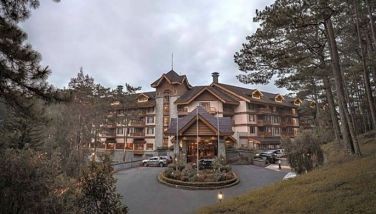RP discovers wild, wet world of river trekking
March 13, 2007 | 12:00am
 DARAITAN, Tanay (AFP) – "There is no right or wrong way," the trailmaster told his nine fellow bushwalkers as they traced a little-known passage through the Sierra Madre range. "But whining is not allowed."
DARAITAN, Tanay (AFP) – "There is no right or wrong way," the trailmaster told his nine fellow bushwalkers as they traced a little-known passage through the Sierra Madre range. "But whining is not allowed."
The city slickers entered a different world in the sleepy village of Daraitan just 50 kilometers east of Manila. Here there are no roads, no bridges, no electricity, no telephones, and no 24-hour convenience stores. The locals speak a lilting, archaic form of Tagalog.
Tents, stoves, pots, clothing, and three days’ worth of food were carried in backpacks as the team walked across the country’s longest mountain range.
Broadly tracking the now languid Daraitan River, the trail rises above the water in the dry season and loops through mountain valleys toward Luzon island’s east coast.
River trekking and its relative canyoning, established sports in parts of the world as diverse as the United States, western Europe, Australia, New Zealand, South Africa, Hong Kong and Taiwan, are relatively new in the Philippines.
"You are the first people I’ve met who would walk into the water on purpose," farmer Freddie Cuerdo told the thirsty trekkers as he sold them coconut milk.
"It’s exciting. It’s a new thing and is something different," said Jennifer Anarna, who climbs mountains outside her day job with a European consumer goods giant.
Spectacular cathedral-sized marble formations, limestone caves, virgin tropical forests, hot springs and scattered settlements of Dumagats line the route.
Among the first known settlers of the Philippines, the semi-nomadic Dumagats spear river fish, trap parrots, wild pigeons and forest game, and weave wicker-like baskets fashioned from tall rattan reeds when not burning the mountain tops to carve out farms.
"Usually, we do forest trails at rising elevations. Crossing rivers, especially with strong currents, is a different experience," said graphic designer Thaddeus Reantaso, like Anarna a member of Manila-based AMCI Mountaineering Club Inc.
Interest in adventure tourism – mountain and rock climbing, spelunking (caving), scuba diving, offroad rallying, and white water rafting are also gaining popularity  is fed by higher disposable incomes.
"The climbing season started earlier. Usually the climbing starts next month," said the trailmaster who goes by the name Oca. "Consumer confidence is much better than last year."
Even as paychecks rise, more and more Filipinos are becoming "stressed out and they realize they need the weekend to recharge" through adventure or physical activity, he said.
"We came here to climb a nearby mountain in 1991 and somebody mentioned that this river goes all the way to the Pacific Ocean. It perked up my interest because I had not seen the Pacific at the time," the trailmaster said.
An experienced mountaineer himself, he said climbing "no longer holds any fascination," and he began organizing annual river treks here in 2000.
This year’s team, all AMCI members with several hundred mountain summits under their collective belts, kept their backpacking boots dry in the first four hours by scrambling along the rocky, at times brush-covered riverbank.
It was slow going under the hot tropical sun and the day was broken up with regular rest breaks with freshly brewed coffee and food in the shade of trees or rock overhangs.
At times, the only trail signs to go by are the red stains of betel nut spit out by the Dumagats, who chew the bitter mildly narcotic fruit to make their river commute more bearable.
The trailmaster told the team of 20-somethings and baby boomers that it was up to them to find the best route downstream. "The river trail has a logic of its own," he said.
By noon the river had narrowed to a deep channel framed by two smooth vertical rock walls, forcing the team into the water where they rode their packs like improvised rafts.
Despite using double bin liners sealed with rubber bands to waterproof their packs, half the team found their clothing and gear was wet when they pitched camp on a sandbar in late afternoon. A camera and a mobile phone were among the casualties.
They were forced to cook damp pasta for dinner. Aubergines and tomatoes bought from farmers along the way completed the menu.
The next morning they awoke to a cacophony of bird sounds. Black crows, brown hawks, and screeching blue kingfishers patrolled the deep canyon above the water.
A family of Dumagats walked upstream on the far bank, and their dog dived into the water to cross and scavenge among the tents.
A pair of huge hornbills, now rarely seen in depleted Philippine forests, emerged above the canopy, their red bills and long yellow tails standing out in the sun-drenched foliage that sagged under their weight.
Giant rotting logs littered the banks, a constant reminder that despite the breathtaking scenery, this is still a potentially dangerous sport.
The Sierra Madre’s upper reaches unleashed unseasonal flash floods that killed more than 1,000 people along Daraitan and other areas downstream on Nov. 30, 2004.
The trail ended two days later in the hamlet of Pagsangahan, where Daraitan links up with another tributary to form the much bigger Agos River.
Weighed down by their heavy packs, the team had walked a total of 21 hours over three days. Locals say the trail is a mere 23 kilometers (14.3 miles) long and they normally cover it in a single day.
"I would definitely do this again," team member Reantaso said.
"Of course," Anarna agreed.
BrandSpace Articles
<
>
- Latest
Latest
Latest
February 1, 2025 - 5:46pm
By Joanna Perfecto | February 1, 2025 - 5:46pm
January 25, 2025 - 11:30am
By Katrina Guerrero | January 25, 2025 - 11:30am
January 18, 2025 - 1:35pm
By Rupert Paul Manhit | January 18, 2025 - 1:35pm
Recommended





























